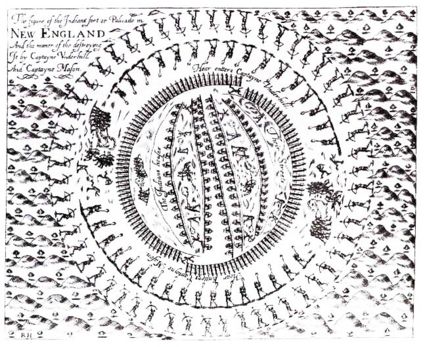Pequot War
The Pequot War was a war between New England settlers and the Pequot Indians in 1637 over control of southern New England. The New Englanders won a complete victory, and the war taught them how to fight Indians.
The first major war in New England was the Pequot War of 1637. The basic issue was whether the colonists would control the territory or whether the Indians would have complete autonomy. Plymouth Colony had deeds that claimed they had purchased the land from the Pequot Indians. Other Indians in the area, especially the Narragansett and Mohegan Indians were the historic enemies of the Pequot, and joined the colonists. Cave (2004) points to a misunderstanding. In 1634 Pequots murdered Captain John Stone, which led to Puritan distrust of the Pequots and became part of the justification for the Puritan "punitive" war. The Pequots were avenging the Dutch execution of the Pequot sachem Tatobem, and they incorrectly thought Stone was Dutch. There is also a strong possibility that the confession to the murder by the Pequots was not really such, but a misinterpretation by the Massachusetts authorities.
The casus bellum was the Pequot murder of John Oldham in 1636. Both sides made preparations for a serious conflict. In April, 1637, a raid on a Pequot village led to a retaliatory raid by Pequot on the town of Wethersfield, Connecticut, killing nine colonists. The government of the recently settled river towns--Windsor, Hartford, and Wethersfield--on May 1, 1637, declared war on the Pequot. Ninety men were levied, supplied, and placed under command of Capt. John Mason. Accompanied by eighty Mohegan under Chief Uncas, they went to Saybrook where they were joined by Capt. Underhill and twenty men from Massachusetts Bay colony. Mason conferred with the Narraganset, Miantonomo, and received further aid. A two-day march overland brought the party to the Pequot fort near present-day Mystic, Connecticut. The fort was surprised and burned (May 26). Only seven Indians escaped the slaughter.
Mason and his men attacked a second Pequot stronghold two miles away the same night. About 300 Pequot warriors and their families from other towns decided to flee west. Meanwhile, the Mason party, reinforced by forty Massachusetts Bay men, returned to Saybrook, while Capt. Israel Stoughton and 120 additional Massachusetts men arrived at New London harbor. After a conference, the two forces decided to pursue the fleeing Pequot, who were caught in Sasqua swamp, near present-day Southport, Conn. The women and children were allowed out of the swamp before the attack was made. The battle on July 13, 1637, resulted in the escape of about 60 Pequot and the capture of 180, who were allotted as slaves to the Mohegan, Narraganset, and Niantic and absorbed into their tribes. The colonists sold the male captives as slaves to the West Indies while they assigned the women as slaves to fellow settlers. Many of those who escaped were hunted down, while chief Sassacus was killed by the Mohawks and his scalp sent to Hartford. The Pequot, as a separate tribe, ceased to exist.
A remnant of Pequots survived and in the late 20th century they acquired federal recognition and built one of the largest casinos in the world in Connecticut.
Hirsch (1988) examines the interaction of Puritan and Indian military cultures in 17th-century New England, focusing on the Pequot War. Both the English and Indians acted within their own military traditions in their relations, and with ethnocentric naivete expected the other to share such values. Thus they were both surprised when the other acted according to an alien code. This misunderstanding of motivations and actions led to the Pequot War, the first Indian-white war in New England, and inspired the slaughter that ended it. The total warfare of King Philip's War, alien to both previous traditions, demonstrated the new synthesis of military practices that had come from this clash of cultures.
The colonists learned they needed Indian allies to fight Indians, that the Indians were tied to their food supplies, and that ambushes had to be avoided.
Karr (1998) traces 17th-century Indian-white relations in Massachusetts, arguing that the violence of the Pequot War of 1637, especially the burning of the Pequot village at Mystic and the slaughter of survivors by Puritan troops, may best be explained by the two groups' alien cultures and inability "to agree on the limits of permissible conduct." Because the English Puritans ignored and denied the Pequots' legitimacy and sovereignty, and were confident of their ultimate victory, they fought the Indians not as they would a European state that shared a code of combat reserved for Christian and external foes but as an illegitimate internal enemy that did not deserve quarter or the protections of a legitimate enemy. Since the warring parties failed "to establish reciprocity" in their fighting during the Pequot War, future Puritan-Indian conflicts, such as King Philip's War, would also be extremely savage and ferocious. Wood (1998) argues that although the merciless treatment of the Pequots might appear to contradict European principles of just warfare, the Puritans justified their actions with references to past Pequot aggression and the religious wars described in the Bible. Puritan theology construed native religion as devil worship or witchcraft. For the Puritans, annihilation of the Pequots was necessary to save God's chosen people from Satan's agents.
Katz (1991) reassesses historians who describe the war as an exercise in genocide in reaction to rather limited threats to English settlements from the Pequots. Such a view, founded on presentist notions of outrage and moral sanctimony, obfuscates the fact that native tribes fought on the side of the English, both sides were mutually responsible for the onset of hostilities, and the colonists were rightfully concerned with threats to their survival. Historians holding to the thesis of genocide overinterpret and occasionally misinterpret their sources to advance their argument.
